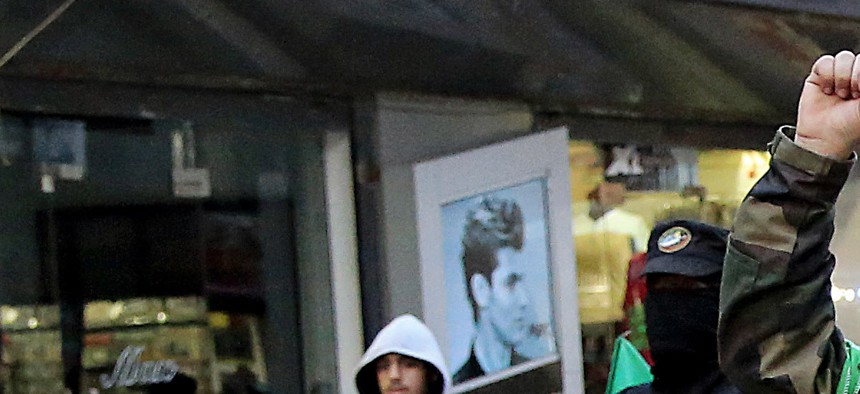
Palestinian masked militants of Izzedine al-Qassam Brigades, a military wing of Hamas, take part in a parade in Gaza on March 23, 2015. Adel Hana/AP
These Groups Were Also Celebrating the Iran Deal
Iranian-backed governments and organizations across the Middle East have reason to cheer on the framework agreement.
As the ink dries on the Lausanne arrangement, there are celebrations on the streets of Tehran and other Iranian cities. Most Iranians undoubtedly regard the bargain stuck with the P5+1 as a win for their country: They get to keep a nuclear program, however restricted, and will—contingent on keeping their own end of the deal—be freed from economic sanctions.
It’s hard not to cheer with a people who have for years been caught between the anvil of sanctions and the hammer of a brutish, corrupt regime.
But it is sobering to remember some of the other people who’ll be celebrating the news from Lausanne. For the puppets and proxies Iran has created and cultivated over three decades, their sponsor’s release from economic shackles promises pennies from heaven.
Syria
If you listened carefully, you might have heard the sounds of champagne being uncorked last night in the Damascus palace of Syria’s dictator, Bashar al-Assad. He’d been having an exceptionally bad week: He had lost control of Idlib, a vital provincial capital in the north, to a rebel force made up of al-Qaeda-linked groups and secular opponents. Perhaps more terrifying, his other nemesis, ISIL, had reached into the Yarmouk refugee camp, just miles from Assad’s palace.
Assad has been kept in power by Iran, both through direct military andfinancial assistance and with battlefield support from Lebanon’s Tehran-backed Hezbollah militia. The preservation of the Assad regime is a longstanding Iranian priority, endorsed by its cleric-president, Hassan Rouhani. But, as his latest losses indicate, Assad needs much more help—and Iran will now be able to provide it, thanks to sanctions relief from the West. No surprise, then, that Syria welcomed the agreement.
Hezbollah
It would not be Hezbollah’s style to uncork champagne, but yesterday’s news will also bring delight to Iran’s oldest, most steadfast surrogate in the Middle East. At Tehran’s bidding, Hezbollah has deployed thousandsof its fanatical Shia fighters with Assad’s military. In nearly four years of fighting, the war has been a severe drain, especially of its best commanders and fighters: Their funerals have become a routine occurrence in Lebanon.
For Hassan Nasrallah, Hezbollah’s leader, the loss of so many fighters is especially worrisome given the constant prospect of another war with Israel. He will need fresh injections of money and materiel, as well as training for new legions. Just as Tehran contemplates the windfall from sanctions relief, Nasrallah will be preparing an invoice for services rendered.
Hamas
There may be another in the mail from Gaza, where Tehran’s other pet terrorist group, Hamas, is rebuilding after last year’s pounding at the hands of the Israeli military. (A new Amnesty International report fingers Hamas for war crimes during the fighting, just as a previous one fingered Israel.) Having shot off most of its inventory of rockets, Hamas will need to rebuild its stocks with the help of its old supplier.
Iraqi Shia Militias
The demands from Iran’s surrogate Shia militias in Iraq—the likes of Asa’ib Ahl al-Haq and the Badr Organization—will be somewhat leavened by the fact that they can also turn to the Shia-led government in Baghdad for financial aid. Indeed, some of the militia leaders are in the government. For the moment, these groups’ main requirement from Iran is organizational and military leadership, often delivered byTehran’s go-to terrorist trainer, Qassem Suleimani.
The Shia militias are currently on a high, having helped the Iraqi military—with US air support—liberate Tikrit from ISIL (paywall). They are reveling in their triumph by looting the city, and spraying walls withsectarian messages to taunt the mostly Sunni population.
Ostensibly, the Shia militias are meant to be auxillaries in the fight against ISIL. But there are signs that they’re being set up as permanent armed groups, operating independently from the government—much like Hezbollah in Lebanon. Asa’ib Ahl al-Haq is developing its own improvised missiles, not unlike Hamas in Gaza. These efforts will require ever greater Iranian assistance—and cash.
The Houthis
And then there are Tehran’s newest plaything, the Houthis of Yemen. This Shia militia has now controls much of the country from the northern border with Saudi Arabia and the southern port of Aden. Motivated by local rivalries and grievances, the Houthis have also received arms, funds and training from Iran. They are now being bombed by a coalition of Sunni countries led by Saudi Arabia, with US intelligence support.
Having served Tehran’s purpose of putting the fright into Riyadh, the Houthis will now need more Iranian assistance in standing up to the Saudi-led coalition. Like all of other Iran’s cat’s paws in the Middle East, they too will have been buoyed by the news from Lausanne.



